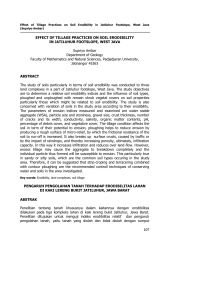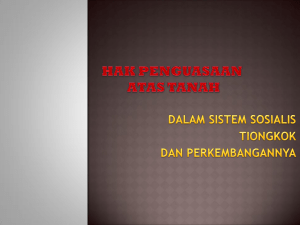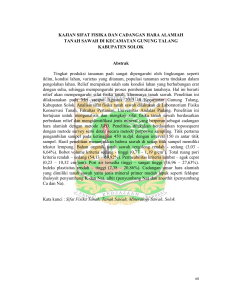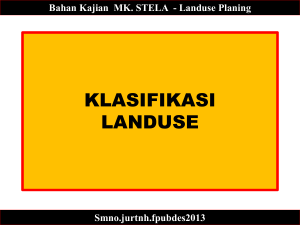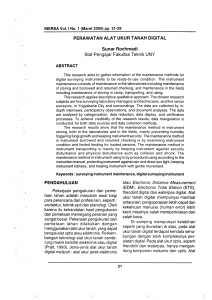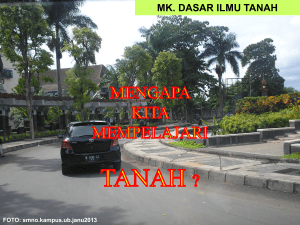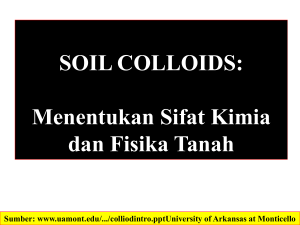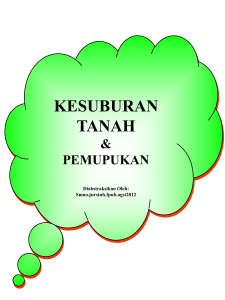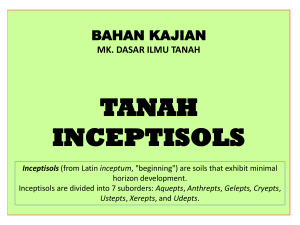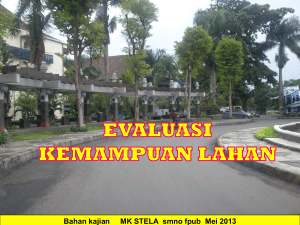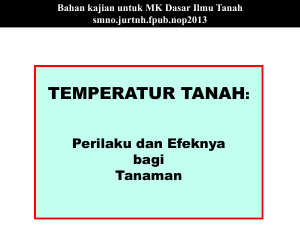dasar ilmu tanah
advertisement
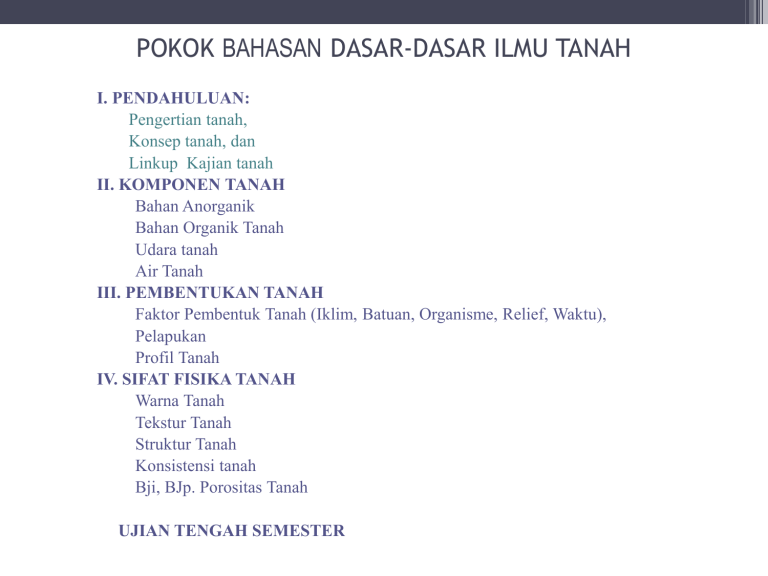
POKOK BAHASAN DASAR-DASAR ILMU TANAH I. PENDAHULUAN: Pengertian tanah, Konsep tanah, dan Linkup Kajian tanah II. KOMPONEN TANAH Bahan Anorganik Bahan Organik Tanah Udara tanah Air Tanah III. PEMBENTUKAN TANAH Faktor Pembentuk Tanah (Iklim, Batuan, Organisme, Relief, Waktu), Pelapukan Profil Tanah IV. SIFAT FISIKA TANAH Warna Tanah Tekstur Tanah Struktur Tanah Konsistensi tanah Bji, BJp. Porositas Tanah UJIAN TENGAH SEMESTER II. KOMPONEN TANAH Soil is dynamic resouce (sumber daya) that support plant life. Tanah adalah sistem dispersi. It is made up of different sized mineral particles (sand, silt, and clay) organic matter, and numerous species of living organism. Bahan utama penyusun tanah: 1. Bahan mineral (anorganik) (45-50 %) 2. Bahan organik ( 0 - 5 %) 3. Air (20 – 30 %) 4. Udara (20 – 30 %) Komposisi ini berbeda untuk tiap jenis tanah ataupun tiap lapisan tanah Soil = is a complex mixture of weathered rock fragments, minerals, water and the remains of dead plants and animals air Rock and mineral fragments produced by weathering (regolith) that supports the growth of plants Humus (decayed animal and plant remains) is a small, but essential, component Kering Kapasitas lapangan Bhn. Mineral Bhn. Mineral Udara tanah 50 % Titik layu tetap A. Anorganik • Bahan mineral berasal dari pelapukan batuan • Apa itu batu (rock) atau batuan (sione)? • Batuan dikelompokkan: 1. batuan beku (ignius, batu api) 2. batuan sedimen (endapan, mendapan) 3. batuan metamorfik (alihan, malihan) Aliran lava Figure 4.7 A Granite Rhyolite Diorite Andesite Gabbro Figure 4.7 C Basalt Clastic Sedimentary Rocks Breccia - fragmental A BRECCIA is made of varying sizes of angular fragments cemented together. The name is from the Italian word for “broken stones” or “rubble”. Many form as the result of fault movement; others form as the result of rapid and short transportation, such as landslides. Clastic Sedimentary Rocks Conglomerate - fragmental CONGLOMERATES are very similar to breccias, but the fragments are rounded. The name is from the Latin conglomeratus for “heaped, rolled or pressed together”. These rocks form in alluvial fans, stream beds and pebble beaches. Clastic Sedimentary Rocks Sandstone - fragmental SANDSTONE is made up of fine-grained particles (1/16 –2 mm). The sand grains (often quartz) are commonly cemented by silica, carbonates, clay or iron oxides. Sandstone is identified by its sandy texture – which often translates into a gritty feel. Environments in which sandstones form include beaches, sand bars, deltas and dunes. Coconino Sandstone, the result of a Permian age coastal dune field Clastic Sedimentary Rocks Shale - fragmental SHALE is a very common rock made of silt and clay sized particles. It is generally very thin-bedded and splits along the bedding planes. In fact, the name is probably from the Old English scealu, “shell or husk”. Normally gray to black, shale may be brown to dark red, depending on the amount of included iron oxide. Shales form in quiet environments, such as lakes, swamps, deltas and offshore marine. Black shale, deposited in a offshore basin in a Middle Cambrian sea. Wheeler Shale with trilobite fossil (Elrathia kingii) Fish scales Utah 2. Biochemical Sedimentary Rocks COAL - Biochemical COAL is considered a rock, although it is not composed of minerals, but rather the decomposed remains of large volumes of vegetation that accumulated in a wet, low oxygen environment, such as a swamp or marsh. Peat, Lignite and SubBituminous & Bituminous are sedimentary varieties of coal and are used as fuels. Biochemical Sedimentary Rocks DIATOMITE - Biochemical DIATOMITE, also known as diatomaceous earth, is composed of the siliceous shells of microscopic alga called diatoms. It is light weight and is generally white. San Manuel, AZ Diatomite is used as an abrasive, insecticide, filtering medium, and paint “flattener”. 3. Chemical Sedimentary Rocks Limestone - chemical Uses: LIMESTONE is composed Manufacture of lime and Portland primarily of calcite. Generally cement & to neutralize smokestack it is dense, fine-grained, and gases. usually white to dark gray. Its Finely ground, used as a functional most distinguishing feature is filler in products such as paint, countertops & plastics. its solubility in weak The dust on chewing gum is hydrochloric or acetic acid ground limestone. accompanied by brisk Mild abrasive additive to effervescence. toothpaste. Soil conditioner The environment of deposition if Flux in processing iron and copper generally warm, shallow seas. ores. Therefore, marine invertebrate Building and ornamental stone. fossils are common. Chemical Sedimentary Rocks Limestone - chemical Coquina Crystalline Pleistocene, Rocky Point, Mexico Redwall Limestone Travertine Mayer, AZ Fossiliferous Chemical Sedimentary Rocks CHERT - chemical CHERT is crypto-crystalline quartz. It is often the result of the dissolution of volcanic ash and is sometimes found in extensive beds, such as the novaculite of Arkansas. It has waxy luster, is translucent and fractures conchoidally. Chert can be any color, but extensive beds are generally white to gray. Chemical Sedimentary Rocks GYPSUM - chemical Satin Spar Alabaster Selenite Gypsum & Anhydrite (water-less calcium sulfate), Carlsbad, NM GYPSUM (calcium sulfate) is found in geographically widespread deposits resulting from the evaporation of a body of water, such as ocean basin or playa lake. It is soft (H=2) & usually white to gray. Three varieties are: Alabaster, Satin Spar and Selenite. Gypsum is mined for use in wallboard and plasters, as an agricultural amendment and to control the set/cure time of Portland cement. Chemical Sedimentary Rocks ROCK SALT - chemical ROCK SALT (halite – sodium chloride) is also a deposit resulting from evaporation of a marine basin or playa lake. It has cubic cleavage and tastes salty. Rock salt is used as a source of chlorine and sodium, as a food supplement, in water softeners and as a road de-icer. Halite Trona, CA SLATE - foliated SLATE is derived from shale. It is a dense, microcrystalline rock, but one in which parallel planes are very evident in its slaty foliation – a feature resulting from the alignment of clay and mica minerals,which allows it to split readily into sheets. It may be gray, black, green or red. Uses include roofing, flagstone, pool table tops and “blackboards”. Note the relatively dull luster of slate. PHYLLITE - foliated PHYLLITE is somewhat more metamorphosed than slate. The platy crystals of mica have grown and the rock displays a subtle, satiny shine referred to as “phyllitic sheen”. The name comes from its leaf-like (many fine layers) appearance. Note the phyllitic sheen. SCHIST - foliated SCHIST is medium to coarsegrained, crystalline, with prominent parallel mineral orientation. Typically, it is predominately muscovite mica, which lends a silvery white to gray sparkly appearance. It is not unusual for accessory minerals (such as garnets, staurolite, tourmaline) to grow in the rock. Schist is added to clay mixtures as a strengthening material in vitreous pipe (red sewer) and clay roof tiles. Crumpling of schist due to pressure and collapse of mica crystals tourmaline porphyroblast – note alignment garnet porphyroblast GNEISS - foliated GNEISS formed under conditions of high temperatures and pressures at great depth during regional metamorphism. It is characterized by foliation expressed as black and white banding. Because the rock becomes plastic, the banding is often contorted (squiggly). Gneissic granite – separation of dark & light minerals is just beginning Well banded gneiss Augen = quartz pebble resistant to compression Augen Gneiss kink in gneiss metamorphism of shale SHALE is the most common sedimentary rock. Through the agents of metamorphism it changes to rocks that are stable at higher temperatures and pressures. These changes take place in the solid state. GRANITE MELTING Produces GRANITE Slate Shale Increasing Temperature and Pressure Schist Phyllite Gneiss MARBLE – non-foliated Hewitt Canyon, AZ MARBLE is metamorphosed limestone or dolomite. The colors can vary from pure white to gray, green, yellow, brown, black, red or any combination thereof, depending on the ‘impurities’ in the parent limestone. Bands or streaks result from plastic flow during extreme deformation, due to high pressure and temperature. It is calcite or dolomite and will fizz in weak acids. Marble is used for building facades, floors, countertops, statuary, landscaping, paving/roofing, poultry grit, and as filler/extender for paint, plastics, paper and adhesives. QUARTZITE – non-foliated QUARTZITE is metamor-phosed quartz sand-stone. It is a very dense,durable, massive, microcrystalline rock (but still may retain a slightly sandy look). It can be any color, but tends to be white, tan or pink. SERPENTINITE – non-foliated Chrysotile asbestos Salt River Canyon, AZ SERPENTINITE is composed of one or more minerals in the serpentine family. It is common where wet basalts or mantle rocks are metamorphosed, such as at convergent boundaries. Its green colors, waxy luster, often associated asbestos and common slickensided surfaces are clues to its identity. METACONGLOMERATE – non-foliated Conglomerate METACONGLOMERATE is metamorphosed conglomerate. It retains its pebbly appearance, but while a sedimentary conglomerate will break around the pebbles, a metaconglomerate will break through the pebbles. If temperatures are high enough in the presence of pressure, the pebbles may become squished or flattened and will be elongated parallel to each other (becomes foliated). The other rock Primitive Rocks “primitive rocks” formed directly from the protosolar nebula. Examples of primitive rocks include chondritic meteoritic material. Elemental ratios are in the same ratio as those in the Sun. We will talk more about these when we survey asteroids. Iklim, B. Beku relief B. Endapan organisme B. Malihan waktu TANAH PADATAN TANAH … • Terdapat dalam berbagai ukuran: 50 µm – 2.000 µm pasir 2 – 50 µm debu (lanau) <2µ klei (liat = lempung) Bahan mineral > 2 mm terdiri atas kerikil, kerakal, dan bongkah Padatan tanah Ukuran dan Susunan Ukuran diameter > 2,0 mm batu/batuan 2,0-20 mm kerikil < 2,0 mm bahan tanah halus (fine earth) Bahan tanah halus -pasir 2,00-0,02 mm pasir kasar 2,0-0,2 mm pasir halus 0,2-0,02 mm Sistem International - lanau 0,02-0,002 mm - klei < 0,002 mm (lempung UGM+ITB, liat IPB): Bahan tanah halus Pasir : 0,05 – 2,00 mm Pasir sangat kasar Pasir kasar Pasir sedang Pasir halus Pasir sangat halus 2,00 – 1,00 mm 1,00- 0,50 mm 0,50 – 0,25 mm 0,25 - 1,00 mm 0,10 - 0,05 mm Lanau 0,05 -0,002 mm lanau kasar 0,05 – 0,02 mm lanau sedang 0,02-0,005 mm lanau halus 0,005-0,002 mm Klei < 0,002 mm Klei kasar 0,002-0,0002 mm Klei sedang 0,0002-0,00008 mm Klei halus < 0,0008 mm USDA system Klei dapat berarti = ukuran < 0,002 mm (org./anorg.) = mineral (anorganik) = tekstur Bentuk padatan batang lempeng gumpal menyudut/membulat tidak teratur bola A. MINERAL PRIMER & SEKUNDER Mineral primer: mineral yang berasal langsung dari pembekuan magma (terdapat pada fraksi pasir dan debu) Mineral sekunder: mineral hasil bentukan pelapukan dan pembentukan tanah (terdapat pada fraksi klei) Mineral Primer dalam tanah mineral Formula Keterangan Kuarsa SiO2 Tektosislikat Muskovit KAl2(AlSi3O10)(OH)2 Filosilikat Biotit K(Al,Fe)(AlSi3O10)(OH)2 Filosilikat Felspar ortoklas mikrolin Albit Amfibol (Termolin) Filosilikat K[AlSi3O8 ] K[AlSi3O8] Na[AlSi3O8] Ca2Mg5Si8O22(OH)2 Inosilkat ganda Piroksen enstatit diopsit rhodonit Inosilkat tunggal MgSiO3 Ca,Mg (Si2O6) MnSiO3 olivin (Mg, Fe)SiO4 Nesosilkat / Sorosilikat Epidot Ca2(Al, Fe)3Si3O12 (OH) Inosilikat tunggal MINERAL PRIMER TANAH DAN UNSUR HARA ------------------------------------------------------------------------Mineral Unsur hara ------------------------------------------------------------------------Kuarsa (SiO2) -Kalsit Ca Dolomit Ca, Mg Feldspar: - Ortoklas K - Plagioklas Na, Ca Mika: - Muskovit K - Biotit K, Fe Amfibol (hornblende) Ca, Mg, Fe, Na --------------------------------------------------------------------------- MINERAL PRIMER TANAH DAN UNSUR HARA -------------------------------------------------------Mineral Unsur hara -------------------------------------------------------Piroksin Ca, Mg, Fe Olivin Mg, Fe Leusit K Apatit P -------------------------------------------------------- MINERAL SEKUNDER Beberapa jenis mineral sekunder (mineral liat) yang sering ditemukan di dalam tanah: 1. Kaolinit 2. Haloisit 3. Montmorilonit 4. Gibsit 5. Al-Fe oksida Mineral Primer dan sekunder dalam tanah Nama mineral Formula Mineral klei Kaolinit Si4Al4O10(OH)8 Monmorillonit Mx (Al, Fe, Mg) Si8O20(OH)4 Vermikulit Chlorit (Al,Mg,Fe)(Si,Al)8O20(OH)4 [M,Al,(OH)6](Al, Mg)4(Si,Al)8O20(OH)4 Alofan Si3Al4O12. nH2O Imogolit Si2Al4O10.5H2O Hematit α-Fe2O3 Maghemit γ-Fe2O3 Goetit FeOOH Ferihidrit Fe10O15.9H2O Boehmit γ-AlOOH B. BAHAN ORGANIK • Bahan organik kasar (particulate) • Bahan organik halus (humus) • Humus terdiri dari bahan organik halus, berasal dari hancuran bahan organik kasar, serta senyawa baru yang dibentuk dari hancuran bahan organik tersebut melalui kegiatan mikroba dalam tanah Komponen organik Sisa (residu) organik dan rombakan jaringan jasad Biomasa tanah (flora dan fauna tanah) Humus = bahan organik tanah Akar tumbuh an hidup 10 % b kering Humus 85 % berat kering Flora dan fauna tanah (edafon) 5 % berat kering, terdiri atas fungi, algae, bakteri, aktinomicetes, cacingtanah, makrofauna, Manfaat Bahan Organik Pengaruh bahan organik terhadap sifat tanah dan pertumbuhan tanaman: - memperbaiki struktur tanah sumber hara N, P, S dan unsur mikro Menambah kemampuan tanah menahan air Menambah kemampuan tanah untuk menahan unsur hara - Sumber energi bagi mikroba Humus = BOT Merupakan senyawa yang resisten (tidak mudah hancur), berwarna hitam atau coklat, mempunyai daya menahan air dan unsur hara yang tinggi Humus mempunyai kapasitas tukar kation yang tinggi yang disebabkan oleh gugus funsional (karboksil, karbonil, alkohol, dll.) Struktur asam humat Ukuran koloid (1 nm-10um) Taklarut air Tanah Organik (Gambut) Dijumpai di daerah rawa-rawa Bila kandungan BO > 20 % (untuk tanah pasir) atau > 30 % (untuk tanah liat) dengan ketebalan > 40 cm disebut tanah organik (tanah gambut) Top Soil Tanah yang banyak mengandung humus atau bahan organik adalah tanah lapisan atas atau top soil. Makin ke bawah, kandungan bahan organik makin berkurang, sehingga tanah makin kurus (tidak subur) I. UDARA TANAH Susunan udara tanah berbeda dengan udara di atmosfir; 1. 2. 3. Kandungan uap air > tinggi Kandungan CO2 lebih besar Kandungan O2 lebih kecil Udara dan air mengisi pori-pori tanah. Air mengisi pori-pori mikro, sedangkan udara mengisi pori-pori makro Udara Tanah dan Atmosfer Komposisi Udara tanah (%) Udara atmosfer (%) N2 O2 CO2 <78 20,6 >0,2 78 21 0,3 Ar He CH4 NO2 Sisa Sisa Sisa sisa Sisa Sisa Sisa sisa II. AIR TANAH Air terdapat dalam tanah karena: (1) Diserap (ditahan) oleh masa tanah (2) Tertahan oleh lap. kedap air (3) Keadaan drainase kurang baik. Fungsi air bagi tanaman: (1) Sebagai unsur hara H H O (2) Sebagai pelarut unsur hara (3) Sebagai bagian dari sel-sel tanaman (protoplasma) Macam-macam Air Tanah 1. Air tanah (H2O) a) Air bebas = air gravitasi b) Air Kapiler = dipegang oleh pori/kapilar tanah c) Air higroskopis (air yang menyelimuti partikel tanah) 2. 3. 4. Air tersediakan (KL-TLT) Air tak tersediakan (<TLT) Air tak berguna (air bebas) 5. 6. 7. 8. 9. 10. 11. Kapasitas maksimum (keadaan jenuh) Kapasitas lapangan (jumlah airtanah setelah air gravitasi tersingkirkan) Tara lengas (kadar air disentrifusikan 1000 g, 40 menit) Titik layu tetap Kering angin (kadar air setimbang dengan kadar air udara) Kering oven 2. Larutan Tanah (H2O + solute (linarut) Kation = Na+, K+, Ca+2, Mg+2, Fe+2, NH4+ H+, Al+3 Anion = SiO4-4, H2PO4-, HPO4-2,SO4-2, NO3-1, BO3-3 MACAM AIR TANAH … 1. Air higroskopik Air yang diserap tanah sangat kuat sehingga tidak dapat digunakan tanaman 2. Air kapiler Air yang dapat bergerak ke samping atau ke atas karena gaya kapiler. Sebagian besar air kapiler merupakan air yang tersedia bagi tanaman 3. Air gravitasi Air yang tidak dapat diserap tanah karena adanya pengaruh gaya gravitasi Air kapiler (tersedia bagi tanaman) (1) Kapasitas lapangan Menunjukkan jumlah air terbanyak yang dapat ditahan oleh tanah (2) Titik layu permanen Pada kondisi ini, akar tanaman mulai tidak mampu lagi menyerap air dari tanah, sehingga tanaman menjadi layu (3) Air tersedia Merupakan selisih antara kadar air pada kapasitas lapang dan kadar air pada titik layu permanen TEGANGAN AIR TANAH Kandungan air pada kapasitas lapangan ditunjukkan oleh kandungan air pada tegangan 1/3 bar, sedangkan kandungan air pada titik layu permanen adalah pada tegangan 15 bar. Air yang tersedia bagi tanaman terletak pada tegangan 1/3 – 15 bar Tegangan air ------------------------------------------------------------------------Kelembaban tanah Tegangan air Bar (atm) pF ------------------------------------------------------------------------Jenuh air 0 0 Kapasitas lapang 1/3 2,53 Titik layu permanen 15 4,18 Koefisien higroskopik 31 4,50 Kering oven 10.000 7,0 ------------------------------------------------------------------------ Soil profiles A AO E B C O E Bt R TUGAS 1. Jelaskan pengertian tanah ditinjau dari segi pertanian 2. Jelaskan perbedaan antara pedologi dan edafologi 3. Sebutkan ilmu-ilmu yang berhubungan dengan ilmu tanah 4. Sebutkan komponen utama tanah
